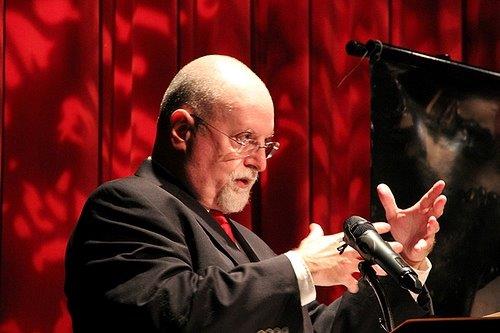an interview with ricardo pau-llosa
Ricardo Pau-Llosa was born in Havana in 1954. When he was six, his family moved to Chicago, then lived in Tampa before settling in Miami when he was a teenager. He has published seven collections of poetry, the last five with Carnegie Mellon U. Press. His third book, Cuba, was nominated for the Pulitzer Prize. He is also a widely published art critic and curator, focusing on modern and contemporary painting and sculpture from Latin America. Pau-Llosa’s poems appeared in december Vols. 24 and 26.1.
DECEMBER:
Why is poetry important?
PAU-LLOSA:
It is an unselfish expression of the intersection of beauty and pure thought based on a medium, language, which is in common use in myriad other ways. I can’t think of other activities which can claim to be all this.
DECEMBER:
What prompted you to begin writing poetry?
PAU-LLOSA:
I was an adolescent when I first understood the need to comprehend and hopefully someday write poetry. I don’t think any one thing or event prompted it, but I can speculate as to why poetry has continued to be existentially relevant – even urgent and ineluctable. Having grown up in a Cuban exile family in an almost entirely North American milieu played a role, I think. We fled communism in 1960 (I was six) and lived, in dire conditions, first in Chicago. A year or so later we moved to Tampa; in 1968 we settled in Miami. Switching between cultures and languages also meant, in the case of exiles, inhabiting two sets of priorities at the same time: the exilic journey and epic of recovery, and the immigrant ambition to take root in an adopted culture and succeed in native life. Poetry was, and still is, the bridge between these two often-conflicting schemes of life and consciousness.
DECEMBER:
Are there any forms you haven’t tried but would like to?
PAU-LLOSA:
I have tried my hand at the sonnet and the villanelle, but I am now gravitating toward forms that take shape of themselves, consistent with what the particular poem demands. Some of these congeal into forms I use in subsequent series, entertain variations, or use as departures for other experiments.
DECEMBER:
You spoke of concreteness in craft and a cinematic quality as being crucial to powerful writing. Could you elaborate on how your love of visual art has influenced your poetry?
PAU-LLOSA:
While one must turn away from the world and toward a page (or screen) to experience a poem, a painting or sculpture faces the challenge of being in the world while it is presenting the viewer with an alternate world. Furthermore, the painting or sculpture usually competes with other works of art in the same space, as well as with people, other objects, and events. Regardless of style, theme, or focus, the work of visual art must impose, rather naturally, its insularity from the world around it in order to alter our experience of that world in an everyday context. By pursuing a poetics of concreteness grounded in the expansive referential power of tropes, I am adapting some of the rigors of the visual artist’s mind to my approach to writing poems, hopefully making them more all-around, enveloping, and less talky, so to speak.
DECEMBER:
Could you describe the importance of having an artistic persona?
PAU-LLOSA:
The artist persona distinguishes itself from the other actors in the psyche on three points: the impulse to create, the impulse to metabolize the events (physical and psychical) of life into art, and the impulse toward atemporality in reflection, expression, and creative endeavor.
DECEMBER:
Where do you write?
PAU-LLOSA:
Mostly at home, on my desktop computer, but I always have writing and drawing pads on me. Obviously, one lives writing in the mind, speculating and imagining, reflecting and establishing currents between history of art and ideas, memories, and immanence. Composing is but one step in a creative process that is far more complex, silent, and unpredictable.
DECEMBER:
What are the most important elements of good writing?
PAU-LLOSA:
Vividness, originality, veracity. A work of art should also appear to have escaped the author’s intention in some way, i.e., to have a life of its own. Clearly, it is not enough for it to articulate a position on an issue or ventilate a feeling, for issues come and go and feelings, being universal, by themselves are open invitations to indulge in predictability. The work of art can only live perpetually in the minds of others in lucid ambiguities and contagious ironies.
DECEMBER:
How does an artist strike a balance between convention and personal style?
PAU-LLOSA:
It is obvious that the volatile balance between universal necessities and individuated desires drive cultures and individuals, past and present. How this balance is struck, or is undone, in each instance defines what is singular in people, events, works of art, cultures, political systems, etc.
DECEMBER:
Could you describe how Cuba evolved into a complete manuscript?
PAU-LLOSA:
I had always wanted to write about Cuba and its role in the shaping of my mind, but it wasn’t until the momentous events of 1989 – fall of Soviet bloc, Tiananmen Square, the Ochoa trial in Cuba – that I came up with a tone and style which was right for this aspiration. It overtook me. I wrote it within 10 months.
DECEMBER:
What tools are must-haves for writers?
PAU-LLOSA:
The most personal of freedoms – the political ones.
DECEMBER:
What is your favorite cigar?
PAU-LLOSA:
Finally, an easy question. Sosa Family Selection, especially the Cameroon or Sumatra wrappers.
Senior Editor Ron A. Austin interviewed Ricardo Pau-Llosa for the first installment of december’s new monthly contributor interview.

